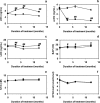Vitamin K2 supplementation improves hip bone geometry and bone strength indices in postmenopausal women
- PMID: 17287908
- PMCID: PMC1915640
- DOI: 10.1007/s00198-007-0337-9
Vitamin K2 supplementation improves hip bone geometry and bone strength indices in postmenopausal women
Abstract
Vitamin K mediates the synthesis of proteins regulating bone metabolism. We have tested whether high vitamin K(2) intake promotes bone mineral density and bone strength. Results showed that K(2) improved BMC and femoral neck width, but not DXA-BMD. Hence high vitamin K(2) intake may contribute to preventing postmenopausal bone loss.
Introduction: Vitamin K is involved in the synthesis of several proteins in bone. The importance of K vitamins for optimal bone health has been suggested by population-based studies, but intervention studies with DXA-BMD as a clinical endpoint have shown contradicting results. Unlike BMC, DXA-BMD does not take into account the geometry (size, thickness) of bone, which has an independent contribution to bone strength and fracture risk. Here we have tested whether BMC and femoral neck width are affected by high vitamin K intake.
Methods: A randomized clinical intervention study among 325 postmenopausal women receiving either placebo or 45 mg/day of vitamin K(2) (MK-4, menatetrenone) during three years. BMC and hip geometry were assessed by DXA. Bone strength indices were calculated from DXA-BMD, femoral neck width (FNW) and hip axis length (HAL).
Results: K(2) did not affect the DXA-BMD, but BMC and the FNW had increased relative to placebo. In the K(2)-treated group hip bone strength remained unchanged during the 3-year intervention period, whereas in the placebo group bone strength decreased significantly.
Conclusions: Vitamin K(2) helps maintaining bone strength at the site of the femoral neck in postmenopausal women by improving BMC and FNW, whereas it has little effect on DXA-BMD.
Figures



Similar articles
-
Three-year low-dose menaquinone-7 supplementation helps decrease bone loss in healthy postmenopausal women.Osteoporos Int. 2013 Sep;24(9):2499-507. doi: 10.1007/s00198-013-2325-6. Epub 2013 Mar 23. Osteoporos Int. 2013. PMID: 23525894 Clinical Trial.
-
Effects of femoral neck width and hip axis length on incident hip fracture risk: a registry-based cohort study.J Bone Miner Res. 2025 Mar 15;40(3):332-338. doi: 10.1093/jbmr/zjaf019. J Bone Miner Res. 2025. PMID: 39869781 Free PMC article.
-
Femoral neck width genetic risk score is a novel independent risk factor for hip fractures.J Bone Miner Res. 2024 Apr 19;39(3):241-251. doi: 10.1093/jbmr/zjae002. J Bone Miner Res. 2024. PMID: 38477772 Free PMC article.
-
Vitamin K₂ therapy for postmenopausal osteoporosis.Nutrients. 2014 May 16;6(5):1971-80. doi: 10.3390/nu6051971. Nutrients. 2014. PMID: 24841104 Free PMC article. Review.
-
Effects of vitamin K in postmenopausal women: mini review.Maturitas. 2014 Mar;77(3):294-9. doi: 10.1016/j.maturitas.2013.11.002. Epub 2013 Nov 27. Maturitas. 2014. PMID: 24342502 Review.
Cited by
-
The Medical Benefits of Vitamin K2 on Calcium-Related Disorders.Nutrients. 2021 Feb 21;13(2):691. doi: 10.3390/nu13020691. Nutrients. 2021. PMID: 33670005 Free PMC article. Review.
-
Menatetrenone versus alfacalcidol in the treatment of Chinese postmenopausal women with osteoporosis: a multicenter, randomized, double-blinded, double-dummy, positive drug-controlled clinical trial.Clin Interv Aging. 2014;9:121-7. doi: 10.2147/CIA.S54107. Epub 2014 Jan 8. Clin Interv Aging. 2014. PMID: 24426779 Free PMC article. Clinical Trial.
-
Efficacy of menatetrenone (vitamin K2) against non-vertebral and hip fractures in patients with neurological diseases: meta-analysis of three randomized, controlled trials.Clin Drug Investig. 2009;29(7):471-479. doi: 10.2165/00044011-200929070-00005. Clin Drug Investig. 2009. Retraction in: Clin Drug Investig. 2018 May;38(5):479. doi: 10.1007/s40261-018-0643-3. PMID: 19499964 Retracted. Review.
-
Effect of GGCX gene polymorphism on the responses of serum undercarboxylated osteocalcin and bone turnover markers after treatment with vitamin K2 (menatetrenone) among postmenopausal Thai women.J Bone Miner Metab. 2011 Sep;29(5):606-14. doi: 10.1007/s00774-011-0263-y. Epub 2011 Feb 23. J Bone Miner Metab. 2011. PMID: 21344298 Clinical Trial.
-
Vitamin K treatment reduces undercarboxylated osteocalcin but does not alter bone turnover, density, or geometry in healthy postmenopausal North American women.J Bone Miner Res. 2009 Jun;24(6):983-91. doi: 10.1359/jbmr.081254. J Bone Miner Res. 2009. PMID: 19113922 Free PMC article. Clinical Trial.
References
-
- {'text': '', 'ref_index': 1, 'ids': [{'type': 'DOI', 'value': '10.1007/s00198-003-1484-2', 'is_inner': False, 'url': 'https://doi.org/10.1007/s00198-003-1484-2'}, {'type': 'PubMed', 'value': '12955315', 'is_inner': True, 'url': 'https://pubmed.ncbi.nlm.nih.gov/12955315/'}]}
- Kaptoge S, Dalzell N, Jakes RW, Warchem N, Day NE, Khaw KT, Beck TJ, Loveridge N, Reeve J (2003) Hip section modulus, a measure of bending resistance, is more strongly related to reported physical activity than DXA-BMD. Osteoporos Int 14:941–949 - PubMed
-
- {'text': '', 'ref_index': 1, 'ids': [{'type': 'DOI', 'value': '10.1111/j.1538-7836.2004.00968.x', 'is_inner': False, 'url': 'https://doi.org/10.1111/j.1538-7836.2004.00968.x'}, {'type': 'PubMed', 'value': '15613016', 'is_inner': True, 'url': 'https://pubmed.ncbi.nlm.nih.gov/15613016/'}]}
- Berkner KL, Runge KW (2004) The physiology of vitamin K nutrititure and vitamin K-dependent protein function in atherosclerosis. J Thromb Haemostas 2:2118–2132 - PubMed
-
- {'text': '', 'ref_index': 1, 'ids': [{'type': 'DOI', 'value': '10.1080/13590849961717', 'is_inner': False, 'url': 'https://doi.org/10.1080/13590849961717'}]}
- Schurgers LJ, Geleijnse JM, Grobbee DE, Pols HAP, Hofman A, Witteman JCM, Vermeer C (1999) Nutritional intake of vitamins K-1 (phylloquinone) and K-2 (menaquinone) in The Netherlands. J Nutr Environm Med 9:115–122
-
- {'text': '', 'ref_index': 1, 'ids': [{'type': 'DOI', 'value': '10.1159/000054147', 'is_inner': False, 'url': 'https://doi.org/10.1159/000054147'}, {'type': 'PubMed', 'value': '11356998', 'is_inner': True, 'url': 'https://pubmed.ncbi.nlm.nih.gov/11356998/'}]}
- Schurgers LJ, Vermeer C (2000) Determination of phylloquinone and menaquinones in food: effect of food matrix on circulating vitamin K concentrations. Haemostasis 30:298–307 - PubMed
-
- {'text': '', 'ref_index': 1, 'ids': [{'type': 'DOI', 'value': '10.1016/S0140-6736(84)90321-0', 'is_inner': False, 'url': 'https://doi.org/10.1016/s0140-6736(84)90321-0'}, {'type': 'PubMed', 'value': '6146829', 'is_inner': True, 'url': 'https://pubmed.ncbi.nlm.nih.gov/6146829/'}]}
- Hart JP, Catterall A, Dodds RA, Klenerman L, Shearer MJ, Bitensky L, Chayen J (1984) Circulating vitamin K1 levels in fractured neck of femur. Lancet ii:283 - PubMed
Publication types
MeSH terms
Substances
LinkOut - more resources
Full Text Sources
Other Literature Sources
Medical

